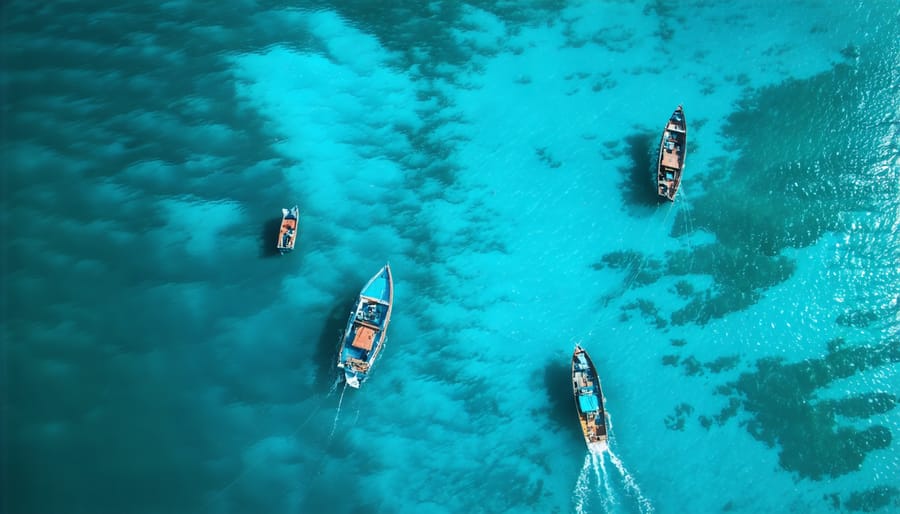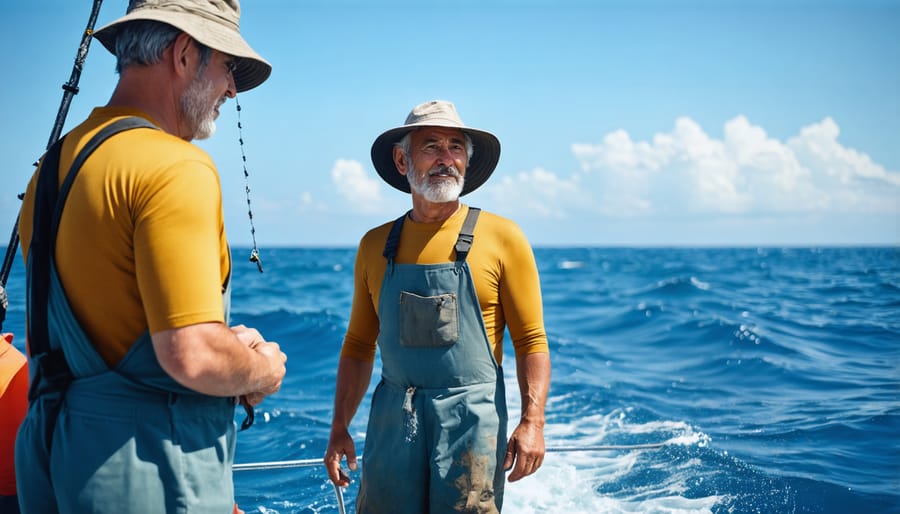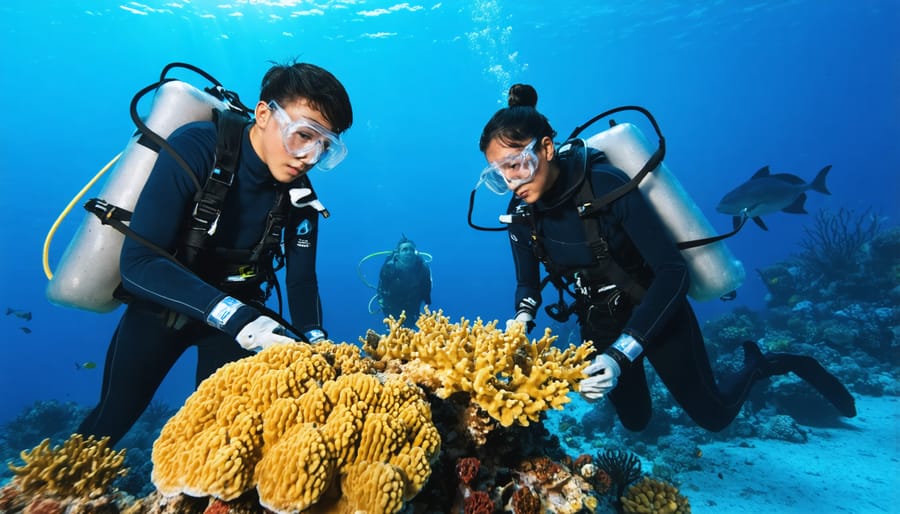
Ocean conservation organizations stand as vital guardians between our planet’s marine ecosystems and the mounting pressures of climate change, overfishing, and pollution. These dedicated groups forge powerful alliances between scientific expertise and coastal communities, creating sustainable solutions that protect both marine life and human livelihoods. From the depths of coral reefs to vast open oceans, these organizations deploy cutting-edge technology and time-tested traditional knowledge to preserve marine biodiversity for future generations.
With over 70% of our planet covered by oceans, the work of marine conservation groups has never been more crucial. These organizations don’t just focus on environmental protection; they pioneer innovative approaches that balance ecological preservation with economic stability, demonstrating that healthy oceans and prosperous communities can coexist. Through their tireless efforts, they’re proving that local action can create global impact, transforming how we interact with and protect our marine resources.
This critical work represents our best hope for maintaining the delicate balance between human needs and ocean health, while ensuring that marine ecosystems continue to thrive for generations to come.
Leading Ocean Conservation Organizations Making a Difference
Global Marine Conservation Organizations
Several prominent international organizations lead the charge in marine conservation through community-centered approaches. The World Wildlife Fund (WWF) Marine Program operates in over 100 countries, implementing locally-managed marine protected areas while supporting sustainable fishing practices. Their successful initiatives include partnering with Pacific Island communities to establish traditional fishing grounds that both preserve cultural heritage and protect marine biodiversity.
Conservation International’s Ocean Health Index program takes a unique approach by combining scientific assessment with community engagement. They work directly with coastal communities to develop conservation strategies that balance environmental protection with economic needs, particularly in developing regions where communities depend heavily on marine resources.
The Nature Conservancy’s Coral Triangle program demonstrates the power of collaborative conservation, working with indigenous communities in Indonesia, the Philippines, and Papua New Guinea. Their approach combines traditional ecological knowledge with modern conservation science, resulting in successful coral reef protection while maintaining sustainable local fisheries.
Oceana, the largest international organization focused solely on ocean conservation, employs a grassroots approach to advocacy and protection. They partner with local fishing communities to establish sustainable practices and create marine protected areas that benefit both marine life and local economies. Their work in Belize has helped establish a network of marine reserves while supporting traditional fishing communities through alternative livelihood programs.
These organizations share a common thread: recognizing that successful marine conservation requires active participation and leadership from local communities, combining traditional knowledge with scientific expertise to create lasting positive change.
Regional Conservation Success Stories
Several regional initiatives have demonstrated remarkable success in balancing marine conservation with community needs. In the Philippines, the Tubbataha Reefs Natural Park showcases how marine protection initiatives can thrive through collaboration between local communities and conservation groups. The park has seen a 300% increase in fish biomass while supporting sustainable tourism that benefits nearby communities.
The Great Barrier Reef’s Traditional Use of Marine Resources Agreements (TUMRAs) exemplifies successful partnerships between Indigenous communities and conservation authorities. These agreements have helped preserve cultural practices while protecting critical marine habitats, resulting in improved coral health and increased fish populations in managed areas.
In the Mediterranean, the success of Croatia’s Lastovo Islands Nature Park demonstrates how small-scale fishing communities can coexist with conservation goals. Local fishers have become integral partners in monitoring marine ecosystem health, while maintaining their livelihoods through sustainable fishing practices.
The Locally Managed Marine Areas (LMMAs) in the Pacific Islands represent another triumph, where traditional knowledge combines with modern conservation techniques. In Fiji alone, over 400 communities now manage their marine resources sustainably, leading to improved fish stocks and enhanced food security for local populations. These initiatives prove that when local communities take leadership roles in conservation efforts, both marine ecosystems and human societies benefit.
Innovative Approaches to Community-Based Conservation

Sustainable Fishing Programs
Sustainable fishing programs represent a crucial bridge between marine conservation and community well-being. These initiatives work to preserve both ocean ecosystems and traditional maritime practices while ensuring food security for coastal populations.
Organizations like the Marine Stewardship Council (MSC) lead certification programs that help fisheries transition to sustainable practices. These programs typically involve three key components: establishing catch limits based on scientific data, implementing selective fishing gear to reduce bycatch, and creating protected areas where fish populations can recover.
The Fishing for the Future initiative, launched in 2018, has successfully helped over 200 small-scale fishing communities adopt sustainable methods. This program provides training in modern conservation techniques while respecting local knowledge and cultural practices. Participating communities have reported up to 40% increase in fish populations within their waters while maintaining stable income levels.
Community-based monitoring systems play a vital role in these programs’ success. Local fishers use mobile apps to record catch data, helping scientists track fish populations and adjust guidelines accordingly. This collaborative approach ensures that conservation efforts remain practical and economically viable for fishing communities.
Educational components are equally important, with programs offering workshops on marine ecosystem health, sustainable fishing techniques, and market access for sustainably caught fish. Many organizations also facilitate partnerships between fishing communities and restaurants or retailers committed to sourcing sustainable seafood, creating economic incentives for conservation-minded fishing practices.
Alternative Livelihood Development
Conservation organizations increasingly recognize that protecting marine ecosystems requires addressing the economic needs of coastal communities. Many groups now implement comprehensive programs that create sustainable alternatives to destructive fishing practices and resource exploitation.
The Blue Ventures initiative in Madagascar exemplifies this approach through their eco-tourism development programs, which train local fishers as dive guides and marine naturalists. This transformation has generated steady income while fostering environmental stewardship among community members.
In Indonesia, the Coral Triangle Center partners with coastal villages to establish seaweed farming operations, providing families with reliable revenue streams that don’t deplete fish populations. Their program has successfully reduced destructive fishing practices while improving household incomes by up to 40%.
The Oceanic Society’s global initiatives focus on developing sustainable handicraft industries using responsibly collected marine materials. In Pacific island communities, they’ve helped establish cooperatives where local artisans create jewelry and decorative items from coconut shells and sustainable pearl farming, reducing pressure on coral reef ecosystems.
WWF’s Smart Gear initiative works with fishing communities to develop and implement more selective fishing equipment, reducing bycatch while maintaining catch values. This technical innovation approach has helped fishers maintain their traditional livelihoods while significantly reducing environmental impact.
These successful programs demonstrate how conservation organizations can create win-win situations, protecting marine environments while ensuring coastal communities thrive economically. By investing in alternative livelihoods, these initiatives build long-term community support for conservation efforts and create sustainable economic models that benefit both people and ocean ecosystems.

Making Conservation Work for Everyone
Traditional Knowledge Integration
Ocean conservation organizations increasingly recognize the invaluable role of traditional ecological knowledge (TEK) in marine protection efforts. Indigenous communities and local fishers, who have lived alongside marine ecosystems for generations, possess deep understanding of local marine species, seasonal patterns, and ecosystem changes that complement scientific research.
Many organizations now actively partner with indigenous communities to integrate their ancestral knowledge into conservation strategies. For example, in the Pacific Islands, conservation groups work with local communities to implement traditional fishing practices that have sustained marine resources for centuries. These include seasonal fishing restrictions, protected areas based on traditional boundaries, and selective harvesting methods that maintain fish populations.
In Australia’s Great Barrier Reef, indigenous sea rangers collaborate with marine scientists to monitor reef health, combining modern survey techniques with traditional understanding of coral ecosystems. This partnership has led to more effective conservation outcomes and stronger community engagement in reef protection initiatives.
The success of TEK integration is particularly evident in marine protected area management. Local communities often serve as guardians of these areas, using their knowledge to identify critical habitats, breeding grounds, and migration patterns. This approach has proven especially effective in regions like Southeast Asia, where traditional fishing communities help enforce no-take zones while maintaining sustainable fishing practices in permitted areas.
Organizations also document and preserve traditional knowledge through oral history projects and community-led research programs. This ensures that valuable ecological information is not lost and can be shared with future generations of conservationists. The combination of traditional wisdom and modern conservation science creates more resilient and culturally appropriate protection strategies for marine ecosystems.

Community Engagement Strategies
Successful ocean conservation organizations recognize that lasting change requires active participation and buy-in from local communities. These organizations employ various strategies to ensure meaningful community engagement and shared decision-making processes.
One effective approach is the establishment of local marine management committees, where community members work alongside scientists and conservation experts. These committees give voice to traditional ecological knowledge and help balance conservation goals with local economic needs. For instance, in the Philippines, community-based marine protected areas have shown remarkable success when fishers participate in patrol teams and help design no-take zones.
Education and capacity building form another crucial component of community engagement. Organizations often conduct workshops, training sessions, and school programs to raise awareness about marine ecosystems and sustainable practices. These initiatives help create a sense of ownership and responsibility while building local expertise in conservation management.
Economic incentives play a vital role in securing community support. Many organizations develop alternative livelihood programs, such as sustainable aquaculture or ecotourism initiatives, which provide income while protecting marine resources. In Indonesia, former destructive fishers now work as coral reef guides and guardians, earning income from conservation rather than exploitation.
Collaborative research programs that involve local participants in data collection and monitoring have proven particularly effective. These citizen science initiatives not only gather valuable data but also deepen community understanding of marine ecosystems and conservation challenges.
Regular community forums and transparent communication channels ensure that local voices are heard and considered in conservation planning. Successful organizations maintain ongoing dialogue with stakeholders, adapt strategies based on feedback, and celebrate conservation achievements together with the community.
Measuring Success: Beyond Environmental Metrics
Modern ocean conservation organizations have evolved beyond simple environmental metrics to embrace a more holistic approach to measuring success. While traditional indicators like species population counts, habitat restoration areas, and water quality measurements remain crucial, organizations now track complex social and economic factors that paint a more complete picture of conservation impact.
Many leading organizations use what’s called the “triple bottom line” framework, evaluating their programs across environmental, social, and economic dimensions. This includes measuring community engagement levels, changes in local income from sustainable fishing practices, and the number of people trained in marine stewardship programs.
The Nature Conservancy, for example, tracks not only coral reef health but also the number of local families benefiting from sustainable tourism initiatives. Similarly, the World Wildlife Fund monitors both marine biodiversity and the economic stability of fishing communities adopting sustainable practices.
Some innovative metrics now being used include:
– Social media engagement and public awareness metrics
– Number of policy changes influenced
– Local employment rates in sustainable maritime industries
– Community health indicators in coastal areas
– Educational program participation rates
– Traditional ecological knowledge preservation
Organizations also increasingly rely on technology for measurement, using satellite monitoring, underwater sensors, and citizen science apps to gather data. This combination of traditional ecological monitoring and modern social impact assessment helps ensure that conservation efforts truly benefit both marine ecosystems and coastal communities.
The future of our oceans depends on finding the right balance between protecting marine ecosystems and supporting the communities that rely on them. Successful ocean conservation organizations have demonstrated that these goals need not be in conflict. By implementing science-based solutions while respecting local knowledge and needs, these organizations have created lasting positive change in marine environments worldwide.
Through collaborative efforts between scientists, local communities, and policymakers, we’ve seen remarkable recoveries in fish populations, the establishment of sustainable fishing practices, and the restoration of critical marine habitats. These achievements show that when we work together, we can create solutions that benefit both marine life and human communities.
However, the challenges facing our oceans continue to grow. Climate change, plastic pollution, and overfishing threaten marine ecosystems at an unprecedented scale. This makes the work of ocean conservation organizations more crucial than ever. Their success depends on continued support from individuals, governments, and businesses worldwide.
You can make a difference by supporting these organizations through volunteering, donations, or simply spreading awareness about marine conservation issues. Whether it’s participating in local beach cleanups, supporting sustainable seafood initiatives, or educating others about marine protection, every action counts toward preserving our ocean heritage for future generations.
Together, we can ensure that our oceans remain healthy, productive, and resilient for centuries to come. The time to act is now.
jessica
Ava Singh is an environmental writer and marine sustainability advocate with a deep commitment to protecting the world's oceans and coastal communities. With a background in environmental policy and a passion for storytelling, Ava brings complex topics to life through clear, engaging content that educates and empowers readers. At the Marine Biodiversity & Sustainability Learning Center, Ava focuses on sharing impactful stories about community engagement, policy innovations, and conservation strategies. Her writing bridges the gap between science and the public, encouraging people to take part in preserving marine biodiversity. When she’s not writing, Ava collaborates with local initiatives to promote eco-conscious living and sustainable development, ensuring her work makes a difference both on the page and in the real world.
